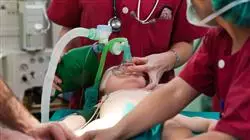University certificate
The world's largest faculty of medicine”
Introduction to the Program
Keeping up to date in the procedures of loco-regional anesthesia and pain management is key to provide better patient care"

New scenarios in anesthesia procedures motivate us to propose new training programs that fit the real needs of experienced professionals, so that they can incorporate advances in local and regional anesthesia, and pain management, into their medical practice”
The need for a differentiated update on obstetric-gynecological anesthesia lies in the fact that the binomial maternal-fetus imposes special conditions that are unique in our environment, to the extent that any therapeutic action has a greater dimension than that of the subject itself. It is therefore necessary to know, supported by solid science, the pathophysiological foundations of maternal-fetal interaction, so that our therapeutic procedures are performed with maximum safety for all.
This program also includes several updated chapters on gynecologic-oncologic anesthesiology, which provide a modern and updated view of the profound therapeutic changes experienced in this field, and the new anesthetic needs to address these new realities.
In a parallel but highly relevant way, the program addresses in depth the consideration of pediatric patients. These patients are their own entity and, on many occasions, present base pathology that differs both in its etiology (congenital diseases) and clinical manifestations, as well as in the way in which they are tolerated, and the criteria established by inexperienced personnel may confuse the degree of severity.
Along with this Postgraduate diploma's specific scientific considerations, the program also includes psychological and affective factors associated with child illnesses. The experience of their pathological process, hospitalization and separation from their parents can transform an irrelevant process into a terrible nightmare with important psychological consequences.
You will be able to learn, through the latest educational technology, the most recent advances in Pediatric and Obstetric-Gynecologic Anesthesiology”
This Postgraduate diploma in Pediatric and Obstetric-Gynecologic Anesthesiology is the most complete and up-to-date scientific program on the market. The most important features of the program include:
- Clinical cases presented by specialists in anesthesiology and other areas. The graphic, schematic, and eminently practical contents with which they are created provide scientific and practical information on the disciplines that are essential for professional practice
- Real high-resolution images of pathologies, diagnostic imaging tests and guided procedures
- Presentation of practical workshops on procedures and techniques
- Algorithm-based interactive learning system for decision-making in the presented clinical situations
- Action protocols with the most important advances in the specialty
- All this will be complemented by theoretical lessons, questions to the expert, debate forums on controversial topics, and individual reflection assignments
- With a special emphasis on evidence-based medicine and research methodologies in anesthesiology
- Content that is accessible from any fixed or portable device with an Internet connection
This Postgraduate diploma may be the best investment you can make when choosing a refresher program for two reasons: in addition to updating your knowledge of Pediatric and Obstetric-Gynecologic Anesthesiology, you will obtain a qualification from TECH Global University”
The teaching staff is made up of a team of leading anesthesiologists, who bring to this training the experience of their work, in addition to recognized specialists in other medical areas.
The multimedia content developed with the latest educational technology will provide the physician with situated and contextual learning, i.e., a simulated environment that will provide immersive training programmed to train in real situations.
This program is designed around Problem Based Learning, whereby the student must try to solve the different professional practice situations that arise during the course. For this reason, you will be assisted by an innovative, interactive video system created by renowned and experienced experts in the field of pediatric and gynecologic anesthesiology with extensive teaching experience.
Incorporate the latest developments in Pediatric and Obstetric-Gynecologic Anesthesiology to your medical practice and improve patient prognosis"

It includes real clinical cases to bring medical practice as close as possible to the development of the program"
Why study at TECH?
TECH is the world’s largest online university. With an impressive catalog of more than 14,000 university programs available in 11 languages, it is positioned as a leader in employability, with a 99% job placement rate. In addition, it relies on an enormous faculty of more than 6,000 professors of the highest international renown.

Study at the world's largest online university and guarantee your professional success. The future starts at TECH”
The world’s best online university according to FORBES
The prestigious Forbes magazine, specialized in business and finance, has highlighted TECH as “the world's best online university” This is what they have recently stated in an article in their digital edition in which they echo the success story of this institution, “thanks to the academic offer it provides, the selection of its teaching staff, and an innovative learning method aimed at educating the professionals of the future”
A revolutionary study method, a cutting-edge faculty and a practical focus: the key to TECH's success.
The most complete study plans on the university scene
TECH offers the most complete study plans on the university scene, with syllabuses that cover fundamental concepts and, at the same time, the main scientific advances in their specific scientific areas. In addition, these programs are continuously being updated to guarantee students the academic vanguard and the most in-demand professional skills. In this way, the university's qualifications provide its graduates with a significant advantage to propel their careers to success.
TECH offers the most comprehensive and intensive study plans on the current university scene.
A world-class teaching staff
TECH's teaching staff is made up of more than 6,000 professors with the highest international recognition. Professors, researchers and top executives of multinational companies, including Isaiah Covington, performance coach of the Boston Celtics; Magda Romanska, principal investigator at Harvard MetaLAB; Ignacio Wistumba, chairman of the department of translational molecular pathology at MD Anderson Cancer Center; and D.W. Pine, creative director of TIME magazine, among others.
Internationally renowned experts, specialized in different branches of Health, Technology, Communication and Business, form part of the TECH faculty.
A unique learning method
TECH is the first university to use Relearning in all its programs. It is the best online learning methodology, accredited with international teaching quality certifications, provided by prestigious educational agencies. In addition, this disruptive educational model is complemented with the “Case Method”, thereby setting up a unique online teaching strategy. Innovative teaching resources are also implemented, including detailed videos, infographics and interactive summaries.
TECH combines Relearning and the Case Method in all its university programs to guarantee excellent theoretical and practical learning, studying whenever and wherever you want.
The world's largest online university
TECH is the world’s largest online university. We are the largest educational institution, with the best and widest online educational catalog, one hundred percent online and covering the vast majority of areas of knowledge. We offer a large selection of our own degrees and accredited online undergraduate and postgraduate degrees. In total, more than 14,000 university degrees, in eleven different languages, make us the largest educational largest in the world.
TECH has the world's most extensive catalog of academic and official programs, available in more than 11 languages.
Google Premier Partner
The American technology giant has awarded TECH the Google Google Premier Partner badge. This award, which is only available to 3% of the world's companies, highlights the efficient, flexible and tailored experience that this university provides to students. The recognition as a Google Premier Partner not only accredits the maximum rigor, performance and investment in TECH's digital infrastructures, but also places this university as one of the world's leading technology companies.
Google has positioned TECH in the top 3% of the world's most important technology companies by awarding it its Google Premier Partner badge.
The official online university of the NBA
TECH is the official online university of the NBA. Thanks to our agreement with the biggest league in basketball, we offer our students exclusive university programs, as well as a wide variety of educational resources focused on the business of the league and other areas of the sports industry. Each program is made up of a uniquely designed syllabus and features exceptional guest hosts: professionals with a distinguished sports background who will offer their expertise on the most relevant topics.
TECH has been selected by the NBA, the world's top basketball league, as its official online university.
The top-rated university by its students
Students have positioned TECH as the world's top-rated university on the main review websites, with a highest rating of 4.9 out of 5, obtained from more than 1,000 reviews. These results consolidate TECH as the benchmark university institution at an international level, reflecting the excellence and positive impact of its educational model.” reflecting the excellence and positive impact of its educational model.”
TECH is the world’s top-rated university by its students.
Leaders in employability
TECH has managed to become the leading university in employability. 99% of its students obtain jobs in the academic field they have studied, within one year of completing any of the university's programs. A similar number achieve immediate career enhancement. All this thanks to a study methodology that bases its effectiveness on the acquisition of practical skills, which are absolutely necessary for professional development.
99% of TECH graduates find a job within a year of completing their studies.
Postgraduate Diploma in Pediatric and Obstetric-Gynecologic Anesthesiology
Anesthesiology is a medical discipline that deals with the administration of drugs that temporarily block the sensation of pain and other senses, in order to perform medical and surgical procedures without pain. In the case of pediatric and obstetric-gynecological anesthesiology, it is a specialty that requires great skill and dexterity, since very delicate situations must be handled. At TECH Global University we created the Postgraduate Diploma in Pediatric and Obstetric-Gynecologic Anesthesiology, with the objective of providing healthcare professionals with high-quality education in this area. During the program, participants will have the opportunity to acquire theoretical and practical knowledge on the main aspects related to the administration of anesthesia in pediatric patients and in women during pregnancy and childbirth.
Be an expert in pediatric and obstetric-gynecologic anesthesiology
.
At TECH we focus on providing health professionals with high quality education that allows them to acquire the knowledge and skills necessary to perform efficiently in the field of pediatric and obstetric-gynecologic anesthesiology. To achieve this, we provide the most comprehensive curriculum on the market, designed by specialists in the field. Our course is designed to provide participants with up-to-date, state-of-the-art knowledge in pediatric and obstetric-gynecologic anesthesiology. Participants will learn about anesthetic pharmacology, preoperative evaluation, intraoperative monitoring, airway management and mechanical ventilation, among other relevant topics. In addition, specific topics such as epidural analgesia and peripheral nerve blocks in obstetrics and gynecology will be addressed.







